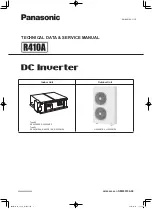
6
DEMO MANUAL DC275
DC/DC CONVERTER
OPERATIO
U
controlled roll off of inductance with DC bias, there is no
magical point where the inductor is no longer useful. Look
at what the inductance will be at the maximum load current
expected and determine if the output ripple will remain
within specified limits. If it will, the inductor will most likely
work correctly. Ripple current is generally designed for
between 10% and 40% of output current.
MOSFET Selection
The main concern with FET selection in very low voltage
applications is thermal management. At high current lev-
els, power devices will get hot. The trick is to keep the
temperature rise within acceptable limits. Most of the
FETs’ power dissipation will be due to conduction losses.
Therefore, by choosing a FET with a sufficiently low R
DS(ON)
,
the power dissipation, and therefore, the temperature rise,
can be made arbitrarily low. The price paid for very low
temperature rise is more expensive FETs. Switching losses
are a concern only for the high side FET. The low side FET
turns on and off into a forward-biased diode, so its tran-
sition losses are very small. The high side FET, in contrast,
must provide all of the reverse recovery charge that the
low side FETs body diode will demand. This can result in
a significant amount of switching loss in this device.
Although it may seem that a lower on-resistance FET is
always desirable from an efficiency perspective, this is not
necessarily true. A smaller device will have a lower gate-
charge power requirement and will also exhibit faster
switching transition times. The resulting reduction in AC
losses may more than offset the increase in conduction
losses. A smaller, higher on-resistance FET may prove the
more efficient, as well as the lower cost solution. As the
load current increases, gate-drive losses become less of a
concern. At output currents on the order of 15A, lower
resistance FETs will probably be better in terms of overall
efficiency, but not necessarily the most cost effective
choice. Each application will place a different value on a
few points of efficiency.
Shutdown/Soft-Start
Each half or the LTC1702 has a RUN/SS pin. This pin
performs two functions: when pulled to ground, each
shuts down its half of the LTC1702, and each acts as a
conventional soft-start pin, enforcing a duty cycle limit
proportional to the voltage at RUN/SS. An internal 4
µ
A
current source pull-up is connected to each RUN/SS pin,
allowing a soft-start ramp to be generated with a single
external capacitor (C7 for side 1 and C17 for side 2) to
ground.
Current Limit
The I
MAX
resistor, R2, sets the current limit by setting the
maximum allowable voltage drop across the bottom
MOSFET before the current limit circuit engages. The
voltage across the bottom MOSFET is determined by its
on-resistance and by the current flowing in the inductor,
which is the same as the output current. To set the current
limit, connect an R
IMAX
resistor from I
MAX
to GND. The
value of R
IMAX
is calculated as follows:
R
IMAX
= [(I
LIM
• R
DS(ON)
) + 100mV]/10
µ
A
I
LIM
should be chosen to be 150% of the maximum
operating load current to account for MOSFET R
DS(ON)
variations with temperature.
How to Measure Voltage Regulation and Efficiency
When trying to measure load regulation or efficiency,
voltage measurements should be made directly across the
V
OUT
and GND terminals and should not be taken at the end
of test leads at the load. Similarly, input voltage should be
measured directly on the V
IN
and GND terminals of the
LTC1702 demo board. Input and output current should be
measured by placing an ammeter in series with the input
supply and load. Refer to Figure 2 for the proper test
equipment setup. Refer to page one for typical efficiency
curves for V
IN
= 5V, V
OUT
= 3.3V, 2.5V and 1.8V, for
I
L
= 1A to 15A.
How to Measure Output Voltage Ripple
In order to measure output voltage ripple, care must be
taken to avoid a long ground lead on the oscilloscope
probe. Therefore, a sturdy wire should be soldered on the
output side of the GND terminal. The other end of the wire
is looped around the ground side of the probe and should
be kept as short as possible. The tip of the probe is touched
directly to V
OUT
(see Figure 3). Bandwidth is generally






























